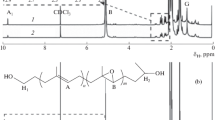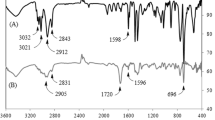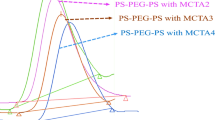Abstract
Synthesis of polysulfone-b-polystyrene (PSU-b-PS) block copolymers by a combination of condensation polymerization and free radical polymerization processes are described. First, a new macroazoinitiator (MAI) containing polysulfone (PSU) units was prepared by direct esterification of 4,4-azobis(4-cyanopentanoic acid) with α,ω-hydroxyl PSU telechelics at ambient conditions. The macroinitiator was then used in conventional free radical polymerization of styrene leading to the formation of desired block copolymers. In this process, initiating macroradicals were generated by thermal cleavage of the azo group present in the macroazoinitiator structure. The precursor polysulfone macroazoinitiator (PSU-MAI) and resulting block copolymers were characterized by spectral analysis using FT-IR, 1H-NMR, GPC, TGA, and DSC.






Similar content being viewed by others
References
Mishra MK, Yagci Y (2009) Handbook of vinyl polymers: radical polymerization, process, and technology. CRC Press, Boca Raton
Nalwa HS (2001) Advanced functional molecules and polymers. Gordon & Breach, Australia
Zhao DY, Huo QS, Feng JL, Chmelka BF, Stucky GD (1998) Nonionic triblock and star diblock copolymer and oligomeric surfactant syntheses of highly ordered, hydrothermally stable, mesoporous silica structures. J Am Chem Soc 120(24):6024–6036. doi:10.1021/ja974025i
Bates FS, Fredrickson GH (1999) Block copolymers—designer soft materials. Phys Today 52(2):32–38. doi:10.1063/1.882522
Kataoka K, Harada A, Nagasaki Y (2001) Block copolymer micelles for drug delivery: design, characterization and biological significance. Adv Drug Deliv Rev 47(1):113–131. doi:10.1016/s0169-409x(00)00124-1
Discher DE, Eisenberg A (2002) Polymer vesicles. Science 297(5583):967–973. doi:10.1126/science.1074972
Jeong B, Bae YH, Lee DS, Kim SW (1997) Biodegradable block copolymers as injectable drug-delivery systems. Nature 388(6645):860–862
Liu JQ, Zhang Q, Remsen EE, Wooley KL (2001) Nanostructured materials designed for cell binding and transduction. Biomacromolecules 2(2):362–368. doi:10.1021/bm015515c
Rzaev ZMO, Dincer S, Piskin E (2007) Functional copolymers of n-isopropylacrylamide for bioengineering applications. Prog Polym Sci 32(5):534–595. doi:10.1016/j.progpolymsci.2007.01.006
Chiefari J, Chong YK, Ercole F, Krstina J, Jeffery J, Le TPT, Mayadunne RTA, Meijs GF, Moad CL, Moad G, Rizzardo E, Thang SH (1998) Living free-radical polymerization by reversible addition-fragmentation chain transfer: the raft process. Macromolecules 31(16):5559–5562. doi:10.1021/ma9804951
Hawker CJ, Bosman AW, Harth E (2001) New polymer synthesis by nitroxide mediated living radical polymerizations. Chem Rev 101(12):3661–3688. doi:10.1021/cr990119u
Matyjaszewski K, Xia JH (2001) Atom transfer radical polymerization. Chem Rev 101(9):2921–2990. doi:10.1021/cr940534g
Guo YM, Pan CY, Wang J (2001) Block and star block copolymers by mechanism transformation. Vi. Synthesis and characterization of a(4)b(4) miktoarm star copolymers consisting of polystyrene and polytetrahydrofuran prepared by cationic ring-opening polymerization and atom transfer radical polymerization. J Polym Sci 39(13):2134–2142
Xu YJ, Pan CY (2000) Block and star-block copolymers by mechanism transformation. 3. S-(PTHF-PSt)(4) and S-(PTHF-PSt-PMMA)(4) from living crop to ATRP. Macromolecules 33(13):4750–4756
Xu YJ, Pan CY (2000) Block and star block copolymers by mechanism transformation. I. Synthesis of PTHF-PST-PTHF by the transformation of ATRP into crop. J Polym Sci A 38(2):337–344
Guo YM, Pan CY (2001) Block and star block copolymers by mechanism transformation. Part V. Syntheses of polystyrene/polytetrahydrofuran A2B2 miktoarm star copolymers by transformation of crop into ATRP. Polymer 42(7):2863–2869
Yagci Y, Serhatli IE, Kubisa P, Biedron T (1993) Synthesis of block copolymers by combination of an activated monomer and free-radical polymerization mechanism. Macromolecules 26(10):2397–2399
Yagci Y, Tasdelen MA (2006) Mechanistic transformations involving living and controlled/living polymerization methods. Prog Polym Sci 31(12):1133–1170. doi:10.1016/j.progpolymsci.2006.07.003
Cianga I, Senyo T, Ito K, Yagci Y (2004) Electron transfer reactions of radical anions with tempo: a versatile route for transformation of living anionic polymerization into stable radical-mediated polymerization. Macromol Rapid Comm 25(19):1697–1702
Tasdelen MA, Yagci Y, Demirel AL, Biedron T, Kubisa P (2007) Synthesis and characterization of block-graft copolymers poly(epichlorohydrin-b-styrene)-g-poly(methyl methacrylate) by combination of activated monomer polymerization, nmp and atrp. Polym Bull 58(4):653–663. doi:10.1007/s00289-006-0708-y
Yagci Y, Duz AB, Onen A (1997) Controlled radical polymerization initiated by stable radical terminated polytetrahydrofuran. Polymer 38(11):2861–2863
Yagci Y (1985) Block copolymers by combinations of cationic and radical routes.1. A new difunctional azo-oxocarbenium initiator for cationic polymerization. Polymer. Communications 26(1):7–8
Hizal G, Yagci Y, Schnabel W (1994) N-alkoxy pyridinium ion terminated polytetrahydrofurans—synthesis and their use in photoinitiated block copolymerization. Polymer 35(20):4443–4448
Galli G, Chiellini E, Yagci Y, Serhatli EI, Laus M, Bignozzi MC, Angeloni AS (1993) Block copolymers with crystalline and side-chain liquid-crystalline blocks. Makromol Chem, Rapid Commun 14(3):185–193
Yagci Y, Onen A, Schnabel W (1991) Block copolymers by combination of radical and promoted cationic polymerization routes. Macromolecules 24(16):4620–4623
Duz AB, Yagci Y (1999) Synthesis of block copolymers by combination of atom transfer radical and promoted cationic polymerization mechanisms. Eur Polym J 35(11):2031–2038
Durmaz YY, Kukut M, Moszner N, Yagci Y (2009) Sequential photodecomposition of bisacylgermane type photoinitiator: synthesis of block copolymers by combination of free radical promoted cationic and free radical polymerization mechanisms. J Polym Sci A 47(18):4793–4799. doi:10.1002/pola.23533
Serhatli IE, Galli G, Yagci Y, Chiellini E (1995) Synthesis of hybrid liquid-crystalline block-copolymers by combination of cationic or promoted cationic and free-radical polymerizations. Polym Bull 34(5–6):539–546. doi:10.1007/bf00423349
Hizal G, Sarman A, Yagci Y (1995) Synthesis of hydroxy-terminated polytetrahydrofuran by photoinduced process. Polym Bull 35(5):567–573
Durmaz YY, Yilmaz G, Yagci Y (2007) N-alkoxy pyridinium ion terminated polystyrenes: a facile route to photoinduced block copolymerization. J Polym Sci A 45(3):423–428
Acik G, Kahveci MU, Yagci Y (2010) Synthesis of block copolymers by combination of atom transfer radical polymerization and visible light radical photopolymerization methods. Macromolecules 43(21):9198–9201. doi:10.1021/ma101967w
Yagci Y (1986) Block copolymers by combinations of cationic and radical routes. 2. Use of polymers with acyl chloride terminal groups in oxocarbenium polymerization. Polymer. Communications 27(1):21–22
Denizligil S, Baskan A, Yagci Y (1995) Bifunctional polytetrahydrofuran initiator for sequential photochemical and thermal initiation. Macromol Rapid Comm 16(5):387–391
Ren Q, Zhang HJ, Zhang XK, Huang BT (1993) Hydrogenated polybutadiene polymethyl methacrylate (HPB PMMA) block copolymer .1. Synthesis of polybutadiene polymethyl methacrylate (PB PMMA) block copolymer. J Polym Sci A 31(4):847–851. doi:10.1002/pola.1993.080310401
Tunca U, Serhatli IE, Yagci Y (1989) Polymerization of acrylamide initiated by the redox system Ce(IV)-4,4′-azobis (4-cyano pentanol). Polym Bull 22(5–6):483–488
Hizal G, Yagci Y (1989) Block copolymers by combination of cationic and radical routes.4. Cationic polymerization of tetrahydrofuran initiated by difunctional azo-oxocarbenium initiator. Polymer 30(4):722–725. doi:10.1016/0032-3861(89)90162-6
Hazer B, Erdem B, Lenz RW (1994) Styrene polymerization with some new macro or macromonomeric azoinitiators having peg units. J Polym Sci A 32(9):1739–1746. doi:10.1002/pola.1994.080320916
Haneda Y, Terada H, Yoshida M, Ueda A, Nagai S (1994) Macro-azo-initiators composed of various polyesters—their syntheses, thermal-properties, and application to block copolymerization. J Polym Sci A 32(14):2641–2652. doi:10.1002/pola.1994.080321405
Simionescu CI, David G, Ioanid A, Paraschiv V, Riess G, Simionescu BC (1994) Solution polymerization of vinyl monomers in the presence of poly(n-acetyliminoethylene) macroazoinitiators. J Polym Sci A 32(16):3123–3132. doi:10.1002/pola.1994.080321612
Tunca U, Yagci Y (1990) Synthesis, decomposition, and initiator properties of macroazonitriles for the preparation of polymers with crown ether units. J Polym Sci A 28(7):1721–1733. doi:10.1002/pola.1990.080280705
Nuyken O, Weidner R (1986) Graft and block copolymers via polymeric azo initiators. Adv Polym Sci 73–74:145–199
Kim DK, Lee SB, Doh KS, Nam YW (1999) Synthesis of block copolymers having perfluoroalkyl and silicone-containing side chains using diazo macroinitiator and their surface properties. J Appl Polym Sci 74(8):1917–1926. doi:10.1002/(SICI)1097-4628(19991121)74:8<1917:AID-APP5>3.0.CO;2-G
Cheikhalard T, Tighzert L, Pascault JP (1996) Polyurethane macroazoinitiators based on 2,2′-azobis(2-cyanopropanol) kinetic studies. J Appl Polym Sci 62(13):2365–2375. doi:10.1002/(SICI)1097-4628(19961226)62:13<2365:AID-APP22>3.0.CO;2-0
Uyanik N, Baysal BM (1990) Preparation of polystyrene-block-(ethylene oxide)s and characterization of the products. J Appl Polym Sci 41(9–10):1981–1993. doi:10.1002/app.1990.070410905
Chang TC, Chen HB, Chen YC, Ho SY (1996) Characterization of azo-containing polydimethylsiloxanes and their copolymers with methyl methacrylate. J Polym Sci A 34(13):2613–2620. doi:10.1002/(SICI)1099-0518(19960930)34:13<2613:AID-POLA7>3.0.CO;2-S
Shimura Y, Chen DJ (1993) Thermodegradable polyurethanes having azo groups in the main chains. 1. Synthesis and thermal properties. Macromolecules 26(19):5004–5008. doi:10.1021/ma00071a003
Olabisi O (1997) Handbook of thermoplastics. Marcel Dekker, New York. http://worldcat.org; http://search.ebscohost.com/login.aspx?direct=true&scope=site&db=nlebk&db=nlabk&AN=12621
Wang F, Hickner M, Kim YS, Zawodzinski TA, McGrath JE (2002) Direct polymerization of sulfonated poly(arylene ether sulfone) random (statistical) copolymers: candidates for new proton exchange membranes. J Membr Sci 197(1–2):231–242. doi:10.1016/s0376-7388(01)00620-2
Hickner MA, Ghassemi H, Kim YS, Einsla BR, McGrath JE (2004) Alternative polymer systems for proton exchange membranes (PEMs). Chem Rev 104(10):4587–4611. doi:10.1021/cr020711a
Guiver MD, Robertson GP, Yoshikawa M, Tam CM (2000) Functionalized polysulfones: Methods for chemical modification and membrane applications. In: Pinnau I, Freeman BD (eds) Membrane formation and modification, vol 744, ACS symposium series, pp 137–161
Paul M, Park HB, Freeman BD, Roy A, McGrath JE, Riffle JS (2008) Synthesis and crosslinking of partially disulfonated poly(arylene ether sulfone) random copolymers as candidates for chlorine resistant reverse osmosis membranes. Polymer 49(9):2243–2252. doi:10.1016/j.polymer.2008.02.039
Higuchi A, Sugiyama K, Yoon BO, Sakurai M, Hara M, Sumita M, Sugawara S, Shirai T (2003) Serum protein adsorption and platelet adhesion on pluronic (TM)-adsorbed polysulfone membranes. Biomaterials 24(19):3235–3245. doi:10.1016/s0142-9612(03)00186-8
Zhao CS, Liu XD, Nomizu M, Nishi N (2003) Blood compatible aspects of DNA-modified polysulfone membrane-protein adsorption and platelet adhesion. Biomaterials 24(21):3747–3755. doi:10.1016/s0142-9612(03)00250-3
Cureton LT, Beyer FL, Turner SR (2010) Synthesis and characterization of hexafluoroisopropylidene bisphenol poly(arylene ether sulfone) and polydimethylsiloxane segmented block copolymers. Polymer 51(8):1679–1686. doi:10.1016/j.polymer.2010.02.010
Bai Z, Houtz MD, Mirau PA, Dang TD (2007) Structures and properties of highly sulfonated poly(arylenethioethersulfone)s as proton exchange membranes. Polymer 48(22):6598–6604. doi:10.1016/j.polymer.2007.08.052
Chen Y, Guo R, Lee CH, Lee M, McGrath JE (2012) Partly fluorinated poly(arylene ether ketone sulfone) hydrophilic-hydrophobic multiblock copolymers for fuel cell membranes. Int J Hydrogen Energy 37(7):6132–6139. doi:10.1016/j.ijhyene.2011.06.139
Lee CH, Xie W, VanHouten D, McGrath JE, Freeman BD, Spano J, Wi S, Park CH, Lee YM (2012) Hydrophilic silica additives for disulfonated poly(arylene ether sulfone) random copolymer membranes. J Membrane Sci 392:157–166. doi:10.1016/j.memsci.2011.12.015
Dizman C, Ates S, Torun L, Yagci Y (2010) Synthesis, characterization and photoinduced curing of polysulfones with (meth)acrylate functionalities. Beilstein J Org Chem 6:56. doi:10.3762/bjoc.6.56
Ates S, Dizman C, Aydogan B, Kiskan B, Torun L, Yagci Y (2011) Synthesis, characterization and thermally activated curing of polysulfones with benzoxazine end groups. Polymer 52(7):1504–1509. doi:10.1016/j.polymer.2011.01.051
Dizman C, Ates S, Uyar T, Tasdelen MA, Torun L, Yagci Y (2011) Polysulfone/clay nanocomposites by in situ photoinduced crosslinking polymerization. Macromol Mater Eng 296(12):1101–1106. doi:10.1002/mame.201100114
Dizman C, Demirkol DO, Ates S, Torun L, Sakarya S, Timur S, Yagci Y (2011) Photochemically prepared polysulfone/poly(ethylene glycol) amphiphilic networks and their biomolecule adsorption properties. Colloids Surf B 88(1):265–270. doi:10.1016/j.colsurfb.2011.06.042
Toiserkani H, Yilmaz G, Yagci Y, Torun L (2010) Functionalization of polysulfones by click chemistry. Macromol Chem Physic 211(22):2389–2395. doi:10.1002/macp.201000245
Karadag M, Yilmaz G, Toiserkani H, Demirkol DO, Sakarya S, Torun L, Timur S, Yagci Y (2011) Polysulfone/pyrene membranes: a new microwell assay platform for bioapplications. Macromol Biosci 11(9):1235–1243. doi:10.1002/mabi.201100024
Yilmaz G, Toiserkani H, Demirkol DO, Sakarya S, Timur S, Torun L, Yagci Y (2011) Polysulfone based amphiphilic graft copolymers by click chemistry as bioinert membranes. Mater Sci Eng C 31(5):1091–1097. doi:10.1016/j.msec.2011.03.010
Yilmaz G, Toiserkani H, Demirkol DO, Sakarya S, Timur S, Yagci Y, Torun L (2011) Modification of polysulfones by click chemistry: amphiphilic graft copolymers and their protein adsorption and cell adhesion properties. J Polym Sci A 49(1):110–117. doi:10.1002/pola.24424
Hazer B, Ayas A, Besirli N, Saltek N, Baysal BM (1989) Preparation of ABCBA-type block copolymers by use of macro-initiators containing peroxy and azo groups. Makromol Chem 190(8):1987–1996
Tasdelen MA, Kahveci MU, Yagci Y (2011) Telechelic polymers by living and controlled/living polymerization methods. Prog Polym Sci 36(4):455–567. doi:10.1016/j.progpolymsci.2010.10.002
Yagci Y, Mishra MK (1994) Macroinitiators in multi-mode polymerization. In: Mishra MK (ed) Macromolecular design: concept and practice (macromonomers, macroinitiators, macroiniferters, macroinimers, macroinifers, macroiniters). Polymer Frontiers International, Hopewell Jct, New York
Simon J, Bajpai A (2001) Synthesis of macroazoinitiator by direct polycondensation for block copolymerization of styrene and butadiene. J Appl Polym Sci 82(12):2922–2933. doi:10.1002/app.2148
Markova D, Kumar A, Klapper M, Muellen K (2009) Phosphonic acid-containing homo-, AB and BAB block copolymers via ATRP designed for fuel cell applications. Polymer 50(15):3411–3421. doi:10.1016/j.polymer.2009.06.011
Kumar A, Pisula W, Markova D, Klapper M, Muellen K (2012) Proton-conducting poly(phenylene oxide)–poly(vinyl benzyl phosphonic acid) block copolymers via atom transfer radical polymerization. Macromol Chem Phys 213(5):489–499. doi:10.1002/macp.201100429
Acknowledgments
The authors thank Istanbul Technical University Research Fund and the State Planning Organization of Turkey (DPT) (Project No: 2005K120920) for the financial support.
Author information
Authors and Affiliations
Corresponding author
Rights and permissions
About this article
Cite this article
Dizman, C., Kahveci, M.U. & Yagci, Y. Synthesis of polysulfone-b-polystyrene block copolymers by mechanistic transformation from condensation polymerization to free radical polymerization. Polym. Bull. 70, 2097–2109 (2013). https://doi.org/10.1007/s00289-013-0931-2
Received:
Revised:
Accepted:
Published:
Issue Date:
DOI: https://doi.org/10.1007/s00289-013-0931-2




